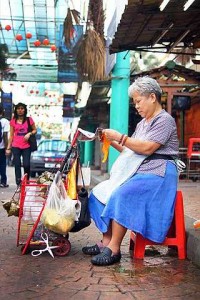By JASON GOH
MANY people say that street photography is one of the hardest to master. That’s probably because there are too many things to capture, and often times we do not know what to focus on and what to filter. Besides requiring the ability to capture the right things and at the right time, this type of photography also requires guts, the eye for good composition and luck.
What is street photography? It’s when your photographs capture the essence of the streets; when you put yourselves into the shoes of people around you, on the streets, on urban roads or just a location open to public. These locations provide you with many things to snap; from people to buildings, objects to sceneries. I’d say a successful street photo is produced when you are able to capture the feelings of the people or a scene, and they resonate with your viewers.
During the previous two photowalks with some R.age readers, I notice that most of the guys had a common challenge, that is taking portrait shots of strangers on the streets. Be it a group of ladies chit-chatting in the market, or an old man sitting alone at the doorstep or random people they find on the street, they were afraid that they might be chased away or scolded for snapping their photos without their knowledge or permission.
I have two approaches to taking photographs of strangers. The first one is to snap and leave. Most people are occupied with their tasks on the streets, and chances are they’d not even be aware of you taking their photographs especially if you are discreet and unobstrusive.
A photographer should be able to blend with his surroundings and not stand out like a sore thumb. The best photographs are of subjects in their most natural state, unconscious of the camera.
Sometimes you might have to run when someone is offended that you have snapped their picture, but that should be a rare occurance if you learn how to keep a good distance and be discreet.
The other approach I’d recommend is to go close and be friendly with your intended subjects. If you used the above ‘snap and leave ’ method, you might get the photo you like but isn’t it better if the subject looks into your camera and smile while performing their daily tasks?
To achieve this, always be friendly and talk to them first. Chat and ask them about their job, things they are selling or even buy something from them. Most of the time, people are friendly and will chat with you. They are happy that someone actually cares and is curious about them. Once you feel they are comfortable with you, ask them ito pose for you. Some people might be reluctant and need persuading, but they’d usually relent.
The next question is should you go close and capture their facial expressions, or capture the whole scene including the surrouding? To me, both are fine depending on what you want to get out of your photographs. Elderly people have wrinkles, and their faces are more complex and textured. It’s better to go close to capture these details. If you want your photo to tell a story, then step further away from the subject and capture the environment too.
The photographs that you are able to capture on the streets will also depend on the lens you use. If you have a wide angle lens like an 18mm one or wider, you should go for the wide shot of the subject and his surrounding. This is because you can’t get too close if you don’t have a portrait lens anyway.
Now if you have a portrait lens (usually 50mm f1.8 or 35mm f1.4) then you should really go close and capture the different facets of people’s faces. The photo will be interesting, with the person’s face being sharp and the background blurred.
This applies to compact camera/digicams too. You can switch to macro mode and go close or just use a normal mode and go wide. It’s your choice.
You may need to practise shooting on the streets a few times, and perhaps be scolded or chased, but that’s cool. Eventually, you will get the hang of street photograph.
Jason Goh blogs at www.smashpop.net.



Tell us what you think!